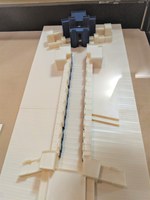Library exhibition on "A Wonder to Behold: Craftsmanship and the Creation of Babylon's Ishtar Gate"
In celebration of ISAW’s latest exhibit “A Wonder to Behold: Craftsmanship and the Creation of Babylon's Ishtar Gate,” the ISAW Library is proud to announce a miniature exhibition of books and artifacts relating to the exhibit. Located on the second floor of ISAW and curated by Anastasia Amrhein, Elizabeth Knott, and Gabriel Mckee, this library exhibition shows publications relating to the excavation of Babylon as well as some notable, newly-created artifacts highlighting aspects of the construction of the Ishtar Gate.
The bibliographical component of this exhibition includes materials on the history of excavations at Babylon, including an early site plan from Claudius James Rich's Narrative of a Journey to the Site of Babylon in 1811, showing the site before excavation; illustrations of the reconstructed Ishtar Gate as imagined by Robert Koldewey, from the publication of the Deutsche Orient-Gesellschaft's excavations; and an image of a cylinder of Nebuchadnezzar inscribed with a text that describes the construction of Babylon's walls and gates.
The centerpieces of this exhibition, however, are not books, but rather three newly-created artifacts that seek to give the Ishtar Gate a physical presence within our space. On loan from the Metropolitan Museum of Art is a replica of a brick mold and an unfired clay brick, showing the process by which the molded figures of mušhuššu dragons and other fearsome creatures were likely created for the Ishtar Gate and the Street of the Processional Way. This mold and brick were created by art conservator J.-F. de Lapérouse of the Metropolitan Museum of Art, and they provide unique insight into the construction of the monumental architecture of Babylon.
 A 3-D printed model of the Ishtar Gate and Processional Way at Babylon, printed by Taylor Shields of NYU's LaGuardia Studio after a digital model created by Olof Pedersén.
Also on display is a 3-D printed model of the Ishtar Gate and the Street of the Processional Way. This 3-D model was printed by Taylor Shields of NYU's LaGuardia Studio based on a digital model created by Olof Pedersén that reflects current scholarly thinking on the size and positioning of Babylon's architecture at the time of Nebuchadnezzar II. Even at a height of less than 7 centimeters, the model stretches over two feet long, showing the enormous scale of the Processional Way (and filling our small display case to its limit). Adding context at a slightly different scale is a different kind of 3-D model: a paper-craft model of the gate itself, sold at the gift shop of the Staatliche Museen zu Berlin and assembled by the ISAW Library's CLIR fellow, Christian Casey. This paper model allows a full-color view of details on the gate that are too small to be visible on the 3-D printed model.
A 3-D printed model of the Ishtar Gate and Processional Way at Babylon, printed by Taylor Shields of NYU's LaGuardia Studio after a digital model created by Olof Pedersén.
Also on display is a 3-D printed model of the Ishtar Gate and the Street of the Processional Way. This 3-D model was printed by Taylor Shields of NYU's LaGuardia Studio based on a digital model created by Olof Pedersén that reflects current scholarly thinking on the size and positioning of Babylon's architecture at the time of Nebuchadnezzar II. Even at a height of less than 7 centimeters, the model stretches over two feet long, showing the enormous scale of the Processional Way (and filling our small display case to its limit). Adding context at a slightly different scale is a different kind of 3-D model: a paper-craft model of the gate itself, sold at the gift shop of the Staatliche Museen zu Berlin and assembled by the ISAW Library's CLIR fellow, Christian Casey. This paper model allows a full-color view of details on the gate that are too small to be visible on the 3-D printed model.
The ISAW Library is excited to provide this bibliographical and artifactual supplement to "A Wonder to Behold." If you are visiting the ISAW Library, please take a moment to visit this exhibit on the second floor.
We are grateful to all those who have helped to make this display possible, especially Jean-François de Lapérouse at the Metropolitan Museum of Art, Taylor Shields and NYU's LaGuardia Studio, Kristen Soule, Christian Casey, Rachel Herschman, and the entire ISAW Exhibition Department.